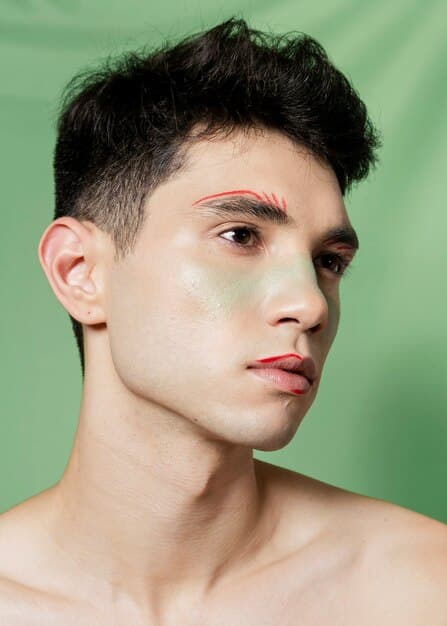Men’s Foundation: Choose Your Perfect Shade (2025 Guide)

Choosing the right foundation shade for men involves understanding skin undertones, matching techniques, and adapting to natural light variations to ensure a seamless, natural-looking finish without appearing overdone or artificial, a crucial aspect of modern grooming in 2025.
In 2025, the conversation around men’s grooming has evolved beyond mere essentials, embracing a nuanced approach to personal presentation. One area gaining significant traction is the use of foundation, not to mask, but to enhance natural skin tone, providing an even complexion and boosting confidence. For those navigating this terrain, the crucial first step is to learn how to choose the right foundation shade for your skin tone: a 2025 guide for men. This isn’t about looking made-up; it’s about perfecting your natural appearance, ensuring your skin looks its best, whether for a professional setting, a special event, or everyday life.
Understanding Your Skin’s Unique Canvas: Tone vs. Undertone
Before diving into a sea of foundation bottles, it’s essential to grasp the fundamental distinction between skin tone and undertone. Many mistakenly believe these terms are interchangeable, but they are critically different and understanding them is the cornerstone of finding your perfect match. Your skin tone, simply put, is the surface color of your skin—what you primarily see. It can range from fair to light, medium, tan, or deep. This is often influenced by sun exposure and can change throughout the year.
However, your undertone is the subtle hue beneath your skin’s surface. This underlying color cast is constant and doesn’t change with sun exposure. Identifying your undertone is perhaps the most important step in selecting foundation, as an incorrect undertone will make even the closest shade match look off, creating an unnatural finish that no one desires. Ignoring your undertone can lead to foundation looking too pink, too orange, or too ashy on your skin.
The Critical Role of Undertone Categories
- Cool Undertones: Your skin has hints of pink, red, or blue. Your veins on your wrist might appear blue or purple. Silver jewelry often looks more flattering on your skin than gold. You might also find that you burn easily in the sun.
- Warm Undertones: Your skin has hints of yellow, gold, or peach. Your veins might appear greenish. Gold jewelry tends to complement your skin more than silver. You also tan easily in the sun and rarely burn.
- Neutral Undertones: Your skin has a balance of both cool and warm tones, or no obvious overtones of either. Your veins may appear a mix of blue and green. Both gold and silver jewelry look good on you. You might tan, but also occasionally burn.
To determine your undertone, a simple wrist test in natural light can be very telling. Look at the veins on the inside of your wrist. If they appear blue or purple, you likely have a cool undertone. If they look green, you probably have a warm undertone. If you see a mix of both, or struggle to clearly differentiate, you might be neutral. Another quick method is the white cloth test: hold a pure white towel or shirt against your bare face. If your skin appears yellowish, you’re warm. If it looks pink or rosy, you’re cool. If it seems to have no obvious cast, you’re neutral. Getting this foundational understanding right sets the stage for a flawless foundation match.
Once you’ve identified whether your undertone is cool, warm, or neutral, this information becomes your guiding light when navigating foundation ranges. Many brands, particularly in 2025, are categorizing their foundations not just by depth of shade (light, medium, dark) but also by undertone. This makes the selection process significantly easier as you can filter out shades that simply won’t work for your natural complexion. Always remember, a well-matched foundation should look invisible on the skin – enhancing, not masking.
Navigating the 2025 Foundation Landscape: Formulations and Finishes for Men
The beauty industry in 2025 offers an unparalleled diversity of foundation formulations, each designed to cater to specific skin types and desired finishes. For men, whose primary goal is often a natural, undetectable enhancement, selecting the right texture and finish is as critical as choosing the correct shade. This section explores the types of foundations available and how their characteristics align with men’s grooming needs, moving beyond the traditional heavy, full-coverage options typically associated with female makeup users.
Understanding these options empowers you to make an informed decision that complements your lifestyle and skin goals, ensuring that the foundation chosen integrates seamlessly with your natural complexion. The wrong formulation can feel heavy, look unnatural, or even exacerbate skin concerns, underscoring the importance of this step in the selection process.
Popular Foundation Types and Their Suitability for Men
- Tinted Moisturizers: These are arguably the most popular entry point for men into foundation. Offering minimal coverage, they primarily aim to even out skin tone, provide hydration, and offer a very natural, “my skin but better” look. They are excellent for those seeking a subtle enhancement without the feel of traditional makeup. Many also include SPF, adding an essential layer of sun protection.
- BB Creams (Blemish Balm): A step up from tinted moisturizers in terms of coverage, BB creams offer slightly more concealment for minor imperfections while still maintaining a natural finish. They often come packed with skincare benefits, such as antioxidants, anti-aging properties, and hydration, making them a multi-tasking product ideal for busy individuals.
- CC Creams (Color Correcting): These creams are designed to address specific skin concerns like redness or dullness. While providing light to medium coverage, their primary function is to neutralize specific discolorations, ensuring a more uniform skin appearance. They are perfect for men who have consistent redness or sallowness they wish to visibly reduce.
- Light-to-Medium Coverage Liquid Foundations: For those who desire more coverage for blemishes, hyperpigmentation, or general unevenness, but still want to avoid a heavy look, liquid foundations labeled as ‘light’ or ‘medium’ coverage are ideal. These can be built up slightly in areas that need more attention and offer a wide range of finishes.
Beyond the type, the finish of a foundation significantly impacts its appearance on the skin. A matte finish offers no shine, which is excellent for oily skin types or those who prefer a completely shine-free look. However, it can sometimes appear less natural. A natural finish is typically the preferred choice for men, mimicking the look of healthy, bare skin. It’s neither overly dewy nor completely matte, striking a perfect balance. A satin finish offers a subtle luminosity without being overtly shiny, providing a healthy glow that looks more like natural skin hydration.
When making your choice, consider your skin type: oily skin benefits from matte or natural finishes, normal to dry skin might prefer natural or satin finishes. Also, think about your lifestyle. If you’re constantly active or outdoors, a lighter formulation with SPF, providing good longevity, might be preferred. The goal is to feel comfortable and confident in your choice, ensuring it seamlessly integrates into your grooming routine without feeling alien or obvious.
The Art of Swatching: Proper Testing Techniques in 2025
Once you have a grasp of your undertone and desired foundation type, the next critical step is the actual shade matching. This is where many go wrong, leading to the dreaded “mask” effect. In 2025, with more nuanced shade ranges and digital tools, the technique of swatching—applying a small amount of product to your skin to test the shade—remains paramount. However, it’s not simply about swiping foundation on your hand. There’s a method to ensure accuracy and blendability.
The goal of proper swatching is to find a shade that literally disappears into your skin. If you can see a line or a patch of color, it’s not the right match. This process requires patience and adherence to specific best practices that enhance accuracy, especially under varying lighting conditions that can significantly alter how a shade appears.
Key Swatching Principles for a Perfect Match
- Test on Your Jawline: Never test foundation on your hand or arm. These areas often have a different skin tone than your face. The most accurate place to swatch is along your jawline, extending slightly down onto your neck. This ensures the foundation blends seamlessly from your face to your neck, avoiding a mismatched “floating head” look.
- Swatch Multiple Shades: Select three shades that you believe are closest to your skin tone and undertone. Apply small stripes of each, side-by-side, on your jawline. Don’t blend them in yet. The one that almost disappears on its own is your potential match.
- Observe in Natural Light: This is perhaps the most crucial step. Store lighting can be deceiving, often making shades appear different than they do in broad daylight. After applying the swatches, step outside or stand near a window with natural light to observe which shade truly melts into your skin. If a shade looks perfect under store lights but off in natural light, it’s not the right one.
- Give it Time: Some foundations oxidize, meaning their color changes slightly after being exposed to air and your skin’s natural oils. This usually happens within 10-15 minutes. Wait a short period after swatching in natural light to see if any of the shades change, ensuring the final color remains a perfect match.

When you’ve found the shade that truly disappears, apply a small amount to your entire jawline and blend it in. If it’s undetectable and makes your skin look naturally better, you’ve likely found your match. Remember that skin tones can shift slightly with seasons due to sun exposure, so you might need a slightly darker or lighter shade for different times of the year. Investing time in proper swatching prevents costly mistakes and ensures you always look your best, with foundation that enhances rather than distracts.
Seasonal Adjustments and Digital Innovation: The 2025 Approach
In 2025, the journey to finding the perfect foundation shade for men has become more dynamic, influenced by both environmental factors and technological advancements. It’s no longer a one-and-done process for the entire year, nor is it solely reliant on in-person guesswork. Understanding how your skin tone can shift with the seasons and embracing digital tools available today can significantly refine your approach to achieving an impeccable match at all times.
Your skin tone naturally fluctuates throughout the year due to varying sun exposure. For instance, you might find yourself a shade or two darker in the summer months compared to the paler complexion you exhibit in winter. Adapting your foundation choice to these seasonal shifts is crucial for maintaining a seamless, natural look.
Adapting to Seasonal Skin Tone Changes
- Summer Foundation: During warmer months, increased sun exposure often leads to a tanned complexion. You may need a foundation that is one or two shades darker than your winter shade. It’s also advisable to opt for more lightweight, natural-finish formulations that stand up better to heat and humidity.
- Winter Foundation: As summer fades, so does your tan, revealing a lighter skin tone. Your foundation should then be adjusted back to a cooler or lighter shade. Foundations that offer more hydration might also be preferred during colder, drier months to prevent flakiness.
- Mixing Shades: For seamless transitions between seasons, or if you find yourself between two shades, consider purchasing two foundations (one lighter, one darker) and mixing them. This allows for custom blend tailored to your exact skin tone on any given day, offering ultimate flexibility and precision.
Leveraging 2025’s Digital Foundation Matching Tools
The beauty industry has made significant strides in digital solutions to aid in foundation matching. Many reputable brands and retailers now offer advanced online tools:
- Virtual Try-On Apps: Utilizing augmented reality (AR) technology, these apps allow you to “try on” various foundation shades virtually using your smartphone camera. While not foolproof, they provide an excellent starting point and can narrow down your choices significantly, minimizing in-store swatching.
- Online Shade Finders: By answering a series of questions about your skin tone, undertone, and even inputting your current foundation shade from another brand, these tools can recommend matching shades. They often use vast databases to cross-reference products, offering surprisingly accurate suggestions.
- AI-Powered Scanners: Some cutting-edge beauty counters now feature AI-powered devices that scan your skin to determine your exact shade and undertone, providing highly personalized recommendations. If available, this is one of the most precise methods for an initial match.
While digital tools are incredibly helpful, they should always be complemented by physical swatching and natural light testing whenever possible. They serve as a powerful preliminary step, streamlining your search and increasing the likelihood of finding the perfect match without endless trial and error. Embracing both traditional and modern methods ensures you’re always putting your best face forward, no matter the season or the year.
Application Techniques: Blending for an Undetectable Finish
Once you’ve meticulously selected the perfect foundation shade and formula, the battle is only half won. The application technique is just as crucial—perhaps even more so—in ensuring that your foundation looks natural and undetectable, rather than like a heavy mask. For men, the goal is enhancement, not concealment, so a light hand and strategic blending are paramount. This section delves into the best practices for applying foundation to achieve that coveted “skin-but-better” effect.
Proper preparation of your skin is the first step towards a smooth foundation application. Hydrated skin provides a better canvas, allowing the product to glide on seamlessly and avoid clinging to dry patches or emphasizing texture. A well-applied foundation should meld with your skin, becoming virtually invisible to the naked eye.
Essential Steps for a Flawless Application
- Prepare Your Skin: Always start with a clean, moisturized face. A good moisturizer helps foundation spread evenly and prevents it from looking patchy. If you have oily skin, consider a mattifying primer in areas prone to shine. This preps your skin, creating a smooth base that enhances foundation longevity and finish.
- Less is More: For men, typically, less foundation is better. Start with a very small amount, focusing on areas that need the most evening out, such as the T-zone, around the nose, or any areas with redness or imperfections. You can always add more if needed, but it’s harder to take away excess.
- Choose Your Tool Wisely:
- Fingers: For tinted moisturizers or BB/CC creams, your clean fingertips can work wonderfully. The warmth from your fingers helps the product melt into the skin for a very natural finish.
- Damp Beauty Sponge: A damp beauty sponge is excellent for liquid foundations, especially if you desire a natural, diffused finish. The dampness helps prevent the sponge from absorbing too much product and creates a seamless, airbrushed look. Bounce the sponge gently onto the skin rather than dragging it.
- Foundation Brush: For slightly more coverage or a more polished look, a flat-top kabuki brush or a dense liquid foundation brush works well. Use circular buffing motions to blend the product into the skin, ensuring no streak marks.
- Focus on Blending: The key to an undetectable finish is diligent blending. Extend the foundation slightly past the areas you’re correcting, blending outwards towards your hairline, ears, and especially down your jawline and onto your neck. There should be no visible line where the foundation starts or ends. Pay extra attention to the edges of your face to avoid a “mask-like” appearance.
- Set (Optional): If you have oily skin or want extra longevity, a very light dusting of translucent setting powder, particularly in your T-zone, can lock your foundation in place without adding color or cakiness. Use a large, fluffy brush for a sheer application.
Mastering these application techniques, coupled with your perfectly matched shade, ensures that your foundation truly enhances your natural skin, providing confidence and a polished appearance without appearing obvious. It’s about refinement, not transformation, and the right technique makes all the difference in achieving that ideal, undetectable finish.
Beyond the Basics: Handling Specific Skin Concerns and Maintenance
While finding the right shade and refining application techniques are foundational, navigating specific skin concerns and understanding daily maintenance can elevate your use of foundation from simply covering to truly enhancing. Many men face common skin challenges—be it acne, redness, dark circles, or oily patches—that require a more targeted approach. Furthermore, ensuring your foundation lasts and maintains its natural appearance throughout the day involves strategic upkeep.
Addressing these concerns goes hand-in-hand with daily application, ensuring that the foundation chosen not only matches but also performs optimally to counteract these issues. A holistic approach considering both application and maintenance will yield the most consistently positive results.
Targeting Common Male Skin Concerns with Foundation
- Acne and Blemishes: For localized breakouts, a slightly higher coverage foundation or a touch of concealer (matched to your foundation shade) can be dabbed precisely onto the blemish using a clean finger or small brush. Blend the edges seamlessly into the surrounding foundation. Avoid over-applying, which can highlight the blemish rather than conceal it.
- Redness (e.g., Rosacea, Post-Shave Irritation): If diffused redness is a primary concern, a CC cream with green undertones can neutralize the redness before foundation application. For more targeted redness, a light-to-medium coverage liquid foundation, applied with a damp sponge, helps to even out the tone without looking heavy.
- Dark Circles Under Eyes: While foundation can offer some mild coverage, a dedicated concealer, typically one shade lighter than your foundation and with a peachy or salmon undertone, is ideal for neutralizing bluish-purple dark circles. Apply sparingly and blend gently with your ring finger or a small brush.
- Oily Skin and Shine: For men with oily skin, selecting a matte-finish foundation or one labeled “oil-free” or “long-wearing” is crucial. Prior to foundation, use a mattifying primer in shine-prone areas. Throughout the day, blotting papers can discreetly absorb excess oil without disturbing your foundation, maintaining a natural look.
Maintaining Your Foundation Throughout the Day
Even the best foundation can falter without the right maintenance. Longevity and a fresh appearance hinge on a few simple strategies:
- Blotting Papers: These are indispensable for managing midday shine. Gently press them onto oily areas (forehead, nose, chin) to absorb excess oil. Do not rub; simply blot.
- Touch-Ups: For minor touch-ups, a small amount of your foundation or a pressed powder can be lightly reapplied to areas that need refreshment. Always use a patting or dabbing motion rather than rubbing.
- Setting Spray: A setting spray can extend the wear of your foundation, especially for long days or in humid conditions. Choose a natural-finish or mattifying spray depending on your skin type. Hold it at arm’s length and mist evenly over your face after applying all liquid products.

By integrating these targeted solutions and maintenance practices, men can ensure their foundation not only starts perfectly but also looks fresh and natural from morning till night. It’s about leveraging products wisely to combat specific concerns, ensuring that your skin always looks its best, revealing a naturally even and confident complexion.
The Evolving Role of Foundation in Men’s Grooming: 2025 and Beyond
As we navigate 2025, the landscape of men’s grooming continues its impressive evolution, shedding antiquated notions and embracing a more holistic and personal approach to self-care. Foundation, once considered exclusively part of women’s beauty routines, is now a legitimate and increasingly mainstream tool for men seeking to refine their appearance subtly. This shift reflects a broader cultural acceptance of male self-expression and a growing understanding that grooming, at its core, is about feeling confident and presenting your best self to the world.
The conversation around men and makeup has matured, moving past sensationalism to a practical discussion about tools for enhancing natural features and addressing skin concerns. The emphasis has firmly shifted from looking “made-up” to achieving a “my skin but better” effect, which aligns perfectly with modern male aesthetics prioritising authenticity and effortless refinement.
Driving Factors Behind Foundation’s Acceptance in Men’s Routines
- Increased Visibility and Education: Social media platforms, male beauty influencers, and dedicated grooming channels have democratized access to information and normalized the use of foundation among men. Tutorials and product reviews geared specifically towards male concerns have empowered individuals to explore these options without stigma.
- Product Innovation: Brands are increasingly formulating products tailored for men, focusing on lightweight textures, natural finishes, and skincare benefits. Packaging has also become more understated and unisex, appealing to a broader demographic. This evolution in product design makes foundation less intimidating and more accessible.
- Professional and Media Influence: From actors and public figures to everyday professionals, men are recognizing the value of a polished appearance in various contexts. Foundation, when applied correctly, can provide that subtle perfection demanded by high-definition cameras or important meetings, contributing to an overall confident demeanor.
The future of men’s grooming promises further integration of traditionally female-centric products, adapted and refined for male needs. Foundation will continue to play a pivotal role in this expansion, with an even greater emphasis on personalization, sustainability, and multi-functional benefits. We can anticipate more custom shade matching services, eco-friendly formulations, and products that simplify routines while maximizing impact.
Ultimately, learning how to choose the right foundation shade for your skin tone: a 2025 guide for men is more than just about cosmetics; it’s about embracing self-care as a means of building self-esteem and navigating the world with enhanced confidence. It’s a testament to the idea that grooming is for everyone, irrespective of gender, and that true confidence stems from looking and feeling your personal best.
Beyond the Basics: Advanced Tips and Troubleshooting for Men’s Foundation
For those men who have mastered the fundamentals of foundation selection and application, there’s always room to refine techniques and troubleshoot common issues. Even with the perfect shade and formula, nuances in skin, environment, and application can affect the final look. This section provides advanced tips to ensure your foundation is always performing at its peak, alongside solutions for everyday challenges that might arise.
Understanding these finer points can elevate your foundation game from good to truly exceptional, ensuring a consistently flawless and natural appearance. It’s about anticipating potential pitfalls and having the knowledge to correct them discreetly and effectively, maintaining that sought-after undetectable finish.
Advanced Application and Blending Techniques
- Targeted Application for Ageing Skin: As skin ages, it may develop fine lines and wrinkles. When applying foundation, especially around the eyes or mouth, use a light hand and a dabbing motion to press the product into the skin rather than rubbing. This prevents foundation from settling into lines and accentuating them. Opt for hydrating and luminous formulas that add a youthful glow, rather than matte finishes which can look flat.
- Addressing Enlarged Pores: If enlarged pores are a concern, a pore-filling primer can be beneficial. After priming, use a stippling motion with a dense brush or sponge to press the foundation into the skin over these areas. This helps to blur the appearance of pores rather than just sitting on top of them, creating a smoother canvas.
- Contouring and Highlighting (Subtly): For a more defined, yet still natural look, consider a very subtle approach to contouring and highlighting. Use a foundation shade that is a half-to-full shade darker for contour (applied sparingly under cheekbones, along the jawline, and sides of the nose) and a lighter shade or subtle highlighter on high points of the face (cheekbones, bridge of nose, brow bone). Blend meticulously to avoid harsh lines.
Troubleshooting Common Foundation Problems
- “Cakey” or Heavy Look: This usually means too much product was applied. Start with less foundation and build coverage only where needed. Ensure your skin is well-hydrated before application. Using a damp beauty sponge often helps to sheer out the product for a more natural finish.
- Foundation Oxidizing/Turning Orange: This occurs when the foundation reacts with your skin’s oils and air. Test foundations for at least 15-20 minutes on your jawline before purchasing. If a foundation consistently oxidizes on your skin, try a different formula or undertone (sometimes a cooler tone can help).
- Patchy or Uneven Application: This can be caused by dry skin patches, insufficient blending, or applying foundation over un-exfoliated skin. Ensure regular exfoliation and good moisturization. Review your application technique, focusing on thorough blending, especially around the edges of the face.
- Foundation Not Lasting/Fading: If your foundation seems to disappear quickly, consider using a good primer suited for your skin type. A setting spray can significantly improve longevity. For very oily skin, ensure you are using an oil-free, long-wearing formula and blot throughout the day.
By understanding these advanced tips and being prepared to troubleshoot, men can truly master the art of foundation. It’s about personalizing your approach to perfectly suit your unique skin and desired outcome, ensuring your refined appearance is consistent and unwavering, no matter the challenges.
| Key Point | Brief Description |
|---|---|
| 🎨 Understand Undertone | Crucial for a natural, seamless match; cool, warm, or neutral. |
| 🧪 Choose Formulation Wisely | Tinted moisturizers, BB/CC creams, or light liquids for natural men’s finish. |
| ☀️ Test in Natural Light | Swatch on jawline and check outside for true shade accuracy. |
| 🛠️ Master Application Techniques | Use minimal product, blend edges, great skin prep for undetectable results. |
Frequently Asked Questions About Men’s Foundation
Skin tone refers to the surface color of your skin (fair, medium, deep), which can change with sun exposure. Undertone, however, is the permanent, subtle hue beneath the surface (cool, warm, or neutral) and is crucial for a foundation that truly blends seamlessly and avoids looking off-color.
Always test foundation shades on your jawline, extending slightly down onto your neck. This area provides the most accurate reflection of your overall complexion and ensures the foundation blends seamlessly from your face to your neck, preventing a visible line.
To avoid a “cakey” look, start with minimal product, applying it only where needed. Ensure your skin is well-moisturized beforehand. Using a damp beauty sponge or fingers for application helps spread the product thinly and seamlessly, ensuring a natural, skin-like finish.
Yes, it’s often advisable to adjust your foundation shade seasonally. Your skin tone typically darkens slightly in summer due to sun exposure and lightens in winter. Having two shades (a summer and a winter tone) or mixing two foundations can help maintain a perfect match year-round.
For a very subtle and undetectable look, tinted moisturizers, BB creams, or CC creams are ideal for men. These formulations offer light coverage to even out skin tone, provide hydration, and often come with added skincare benefits like SPF, yielding a natural “my skin but better” result.
Conclusion
The journey to finding the right foundation shade for men in 2025 is a testament to the evolving dynamics of male grooming. It’s a precise process that, when executed correctly, can profoundly enhance natural features and boost confidence without ever appearing obvious. By thoroughly understanding your skin’s unique undertone, selecting the appropriate formulation for your needs, diligently practicing proper swatching and application techniques, and adapting to seasonal changes, you unlock the full potential of foundation as a powerful, understated grooming tool. This guide isn’t just about makeup; it’s about empowerment—the power to present your most polished and authentic self to the world, seamlessly integrated into your modern lifestyle.





